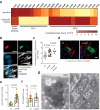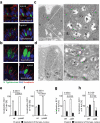SPI2 T3SS effectors facilitate enterocyte apical to basolateral transmigration of Salmonella-containing vacuoles in vivo
- PMID: 34542008
- PMCID: PMC8475570
- DOI: 10.1080/19490976.2021.1973836
SPI2 T3SS effectors facilitate enterocyte apical to basolateral transmigration of Salmonella-containing vacuoles in vivo
Abstract
Salmonella pathogenicity island (SPI) 2 type three secretion system (T3SS)-mediated effector molecules facilitate bacterial survival in phagocytes but their role in the intestinal epithelium in vivo remains ill-defined. Using our neonatal murine infection model in combination with SPI2 reporter technology and RNA-Seq of sorted primary enterocytes, we demonstrate expression of SPI2 effector molecules by intraepithelial Salmonella Typhimurium (S. Typhimurium). Contrary to expectation, immunostaining revealed that infection with SPI2 T3SS-mutants resulted in significantly enlarged intraepithelial Salmonella-containing vacuoles (SCV) with altered cellular positioning, suggesting impaired apical to basolateral transmigration. Also, infection with isogenic tagged S. Typhimurium strains revealed a reduced spread of intraepithelial SPI2 T3SS mutant S. Typhimurium to systemic body sites. These results suggest that SPI2 T3SS effector molecules contribute to enterocyte apical to basolateral transmigration of the SCV during the early stage of the infection.
Keywords: Salmonella; Salmonella pathogenicity island 2 (Spi-2); apical to basolateral transmigration; enterocyte; mucosal translocation.
Conflict of interest statement
The authors declare no competing interests.
Figures




Similar articles
-
Minimal SPI1-T3SS effector requirement for Salmonella enterocyte invasion and intracellular proliferation in vivo.PLoS Pathog. 2018 Mar 9;14(3):e1006925. doi: 10.1371/journal.ppat.1006925. eCollection 2018 Mar. PLoS Pathog. 2018. PMID: 29522566 Free PMC article.
-
Salmonella-containing vacuoles display centrifugal movement associated with cell-to-cell transfer in epithelial cells.Infect Immun. 2009 Mar;77(3):996-1007. doi: 10.1128/IAI.01275-08. Epub 2008 Dec 22. Infect Immun. 2009. PMID: 19103768 Free PMC article.
-
Salmonella enterica Serovar Typhimurium SPI-1 and SPI-2 Shape the Global Transcriptional Landscape in a Human Intestinal Organoid Model System.mBio. 2021 May 18;12(3):e00399-21. doi: 10.1128/mBio.00399-21. mBio. 2021. PMID: 34006652 Free PMC article.
-
[Advances in Salmonella pathogenicity island 2 type III secretion system - A review].Wei Sheng Wu Xue Bao. 2016 Apr 4;56(4):561-9. Wei Sheng Wu Xue Bao. 2016. PMID: 29717847 Review. Chinese.
-
Salmonella effectors: important players modulating host cell function during infection.Cell Microbiol. 2011 Dec;13(12):1858-69. doi: 10.1111/j.1462-5822.2011.01701.x. Epub 2011 Oct 10. Cell Microbiol. 2011. PMID: 21902796 Free PMC article. Review.
Cited by
-
A Small RNA, SaaS, Promotes Salmonella Pathogenicity by Regulating Invasion, Intracellular Growth, and Virulence Factors.Microbiol Spectr. 2023 Feb 14;11(1):e0293822. doi: 10.1128/spectrum.02938-22. Epub 2023 Jan 23. Microbiol Spectr. 2023. PMID: 36688642 Free PMC article.
-
Genotypic and phenotypic analysis of Salmonella enterica serovar Derby, looking for clues explaining the impairment of egg isolates to cause human disease.Front Microbiol. 2024 Jun 6;15:1357881. doi: 10.3389/fmicb.2024.1357881. eCollection 2024. Front Microbiol. 2024. PMID: 38903793 Free PMC article.
-
Dysbiosis and extraintestinal cancers.J Exp Clin Cancer Res. 2025 Feb 7;44(1):44. doi: 10.1186/s13046-025-03313-x. J Exp Clin Cancer Res. 2025. PMID: 39915884 Free PMC article. Review.
-
Non-professional efferocytosis of Salmonella-infected intestinal epithelial cells in the neonatal host.J Exp Med. 2024 Mar 4;221(3):e20231237. doi: 10.1084/jem.20231237. Epub 2024 Feb 2. J Exp Med. 2024. PMID: 38305765 Free PMC article.
-
In vitro and ex vivo modeling of enteric bacterial infections.Gut Microbes. 2023 Jan-Dec;15(1):2158034. doi: 10.1080/19490976.2022.2158034. Gut Microbes. 2023. PMID: 36576310 Free PMC article. Review.
References
Publication types
MeSH terms
Substances
LinkOut - more resources
Full Text Sources
Molecular Biology Databases
Miscellaneous
